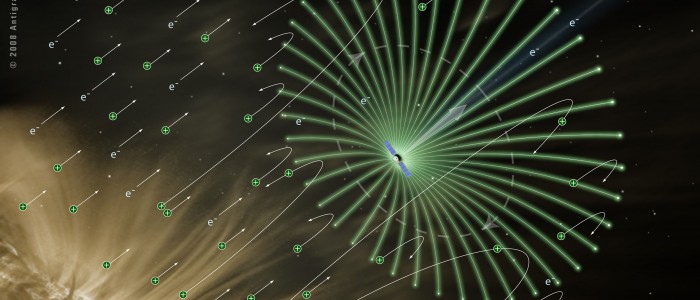Credit figure: Alexandre Szames, Antigravité, Paris
Space rubbish and inactive and outdated (dead) satellites are an increasing threat for satellites in the most used altitudes. The only real way to prevent the accumulation of space debris is to wait for the time they will be caught up by the atmosphere and burn up. The French-American Jason 1 was in June decommissioned in an orbit at around 1300 km height. It is calculated that the satellite will be in a steady lowering orbit for many years before it will burn up in the atmosphere at some point in the future. In the meantime, the satellite is a threat for active satellites in the lower altitudes. It is clear that such an accumulation of rubbish cannot continue.
For active satellites different types of initiatives can be taken. Satellites in the geostationary orbit can be pushed out to a “graveyard orbit”, outside the useful altitude, but still in space. Satellites in low earth orbits can be broken down using the last rest of the fuel and burn up in the atmosphere. Some atmospheric pollution will occur, no doubt, but the inactive satellites will no longer pose a threat to active satellites in orbit.
However, the large and increasing number of small satellites do not have their own engines and cannot be physically broken down, but will stay in the slowly reducing orbit for a long time.
Finnish researchers may possibly have found a cheap solution to the problem; the electric sail effect, and for the first time the effect has been tested in space.
Test at ESTCube – 1
When the Estonia’s first satellite was launched early in May the main payload of the small satellite, which weighs about one kilogram, consists of a 10-metre electric sail tether and an electron gun used for charging the tether. The satellite is Estonian, but The Finnish Meteorological Institute (FMI) bears the main responsibility for the payload.
The principal goal of the mission is to test the opening of the tether and to measure the electric sail effect in space by deploying the 10-metre tether and by charging it to 500 volts. If the electric sail principle works as planned it offers an efficient way to prevent the accumulation of space debris by bringing satellites back into the atmosphere once their service life is over. It will also enable a fast and economical transportation in the solar system without consuming any propellant.
The ESTCube-1 satellite was built by space technology students at Tartu University. The Finnish Meteorological Institute has the main responsibility for the electric sail payload. Important components were built at the Electronics Research Laboratory of the University of Helsinki (electric sail tether), the Accelerator Laboratory of the University of Jyväskylä (electron gun), the University of Eastern Finland (nanographite cathode for the electron gun), and at the German Aerospace Center (DLR) (motorised tether reel).
Additional information:
Research Manager Pekka Janhunen, tel. +358 29 539 4635, [email protected]
https://www.electric-sailing.fi (electric sail)
https://www.estcube.eu (ESTCube-1 satellite)
Credit figure: Alexandre Szames, Antigravité, Paris


